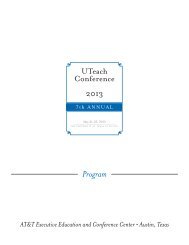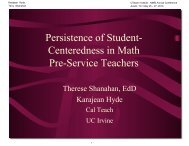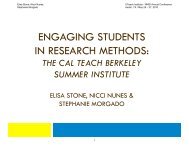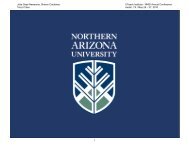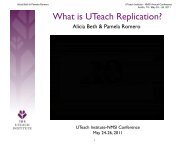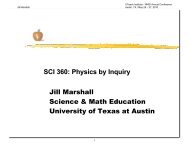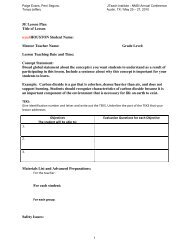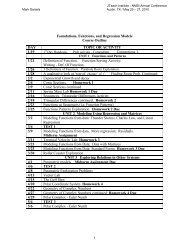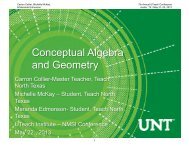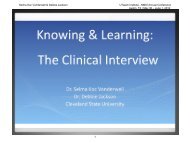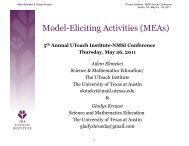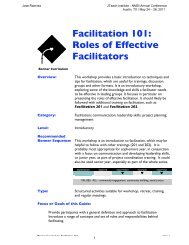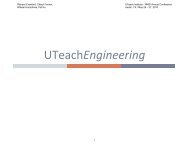Project-Based Instruction - The UTeach Institute
Project-Based Instruction - The UTeach Institute
Project-Based Instruction - The UTeach Institute
Create successful ePaper yourself
Turn your PDF publications into a flip-book with our unique Google optimized e-Paper software.
Martha M. Day, Melissa Rudloff,<br />
and Stephanie Burba<br />
HANDOUTS<br />
<strong>UTeach</strong> <strong>Institute</strong> - NMSI Annual Conference<br />
Austin, TX / May 24 – 26, 2011<br />
Course Syllabus:<br />
Course Syllabus: SMED 470 <strong>Project</strong> <strong>Based</strong><br />
<strong>Instruction</strong><br />
Instructors: Dr. Martha M. Day, Assistant Professor, Science Education, Martha.day@wku.edu<br />
Mrs. Melissa Rudloff, Master Teacher, Science & Mathematics, Melissa.rudloff@wku.edu<br />
Mr. David Almand, Master Teacher, Science & Mathematics, David.almand@wku.edu<br />
Office Hours appointments: Contact Mrs. Karen Long, SKyTeach Coordinator at 270-745-3900 or<br />
Karen.long@wku.edu<br />
Meeting Times/Location: Monday/Wednesday, Section 003 9:10am-11:10am; TCCW 125C<br />
Monday/Wednesday, Section 004 12:40pm-2:40pm; TCCW 125C<br />
Catalog Course Description: 3 credit hours. Methods, techniques, and technologies used to implement and<br />
assess problem-based investigations in math and science classrooms. Fieldwork required; students are<br />
responsible for arranging their own transportation to sites.<br />
Course Description: PBI has three essential components:<br />
<strong>The</strong>ory-driven perspective: Students learn about how people learn and how project-based instruction may be among<br />
our most informed classroom learning environments for bridging the gap between theory and practice.<br />
<strong>Instruction</strong>al Development: Technological and pedagogical content knowledge are developed as <strong>UTeach</strong> students<br />
work toward the design of project-based units. Competency is continually built as students read about and discuss<br />
the principles of PBI; reflect on observations of project-based learning environments in high school settings; and<br />
incorporate what they are learning into the design of problem-based lessons and ultimately, an entire project-based<br />
unit.<br />
Field Experience: An intensive field component includes observation of well-implemented project-based instruction<br />
in local schools as well as implementation of problem-based lessons with area high school students on a study field<br />
trip.<br />
Prerequisites: SMED 320 or MGE 275/PSY 310 (middle grades math or science) or EDU 250/PSY 310/SEC<br />
351/SEC 352 (high school math or science)<br />
Rationale: SMED 470 is designed to provide the teacher candidate with knowledge, skills, and attitudes which<br />
enable them to transmit knowledge required for STEM (Science, Technology, Engineering & Mathematics)<br />
literacy to their students and to assist each teacher with his/her own achievement of the Kentucky Teacher<br />
Standards for Preparation and Certification. <strong>Project</strong>-based instruction engages learners in exploring authentic,<br />
important, and meaningful questions of real concern to students. Through a dynamic process of investigation<br />
and collaboration and using the same processes and technologies that real scientists, applied mathematicians<br />
and engineers use, students work in teams to formulate questions, make predictions, design investigations,<br />
collect and analyze data, make products and share ideas. Students learn fundamental science and mathematical<br />
concepts and principles that they apply to their daily lives. <strong>Project</strong>-based instruction helps all students regardless<br />
of culture, race, or gender engage in learning.<br />
SMED 470 Day, M., Rudloff, M. & Almand, D. Syllabus Page 1 <br />
1
Martha M. Day, Melissa Rudloff,<br />
and Stephanie Burba<br />
HANDOUTS<br />
<strong>UTeach</strong> <strong>Institute</strong> - NMSI Annual Conference<br />
Austin, TX / May 24 – 26, 2011<br />
Required Texts:<br />
John D. Bransford, Ann L. Brown, and Rodney R. Cocking, editors. (1999). How People Learn: Brain, Mind,<br />
Experience and School. National Academy Press: Washington, DC.<br />
http://www.nap.edu/openbook.php?record_id=6160 (Free online textbook)<br />
National Council of Teachers of Mathematics. (2000). Principles and Standards for School Mathematics.<br />
NCTM: Alexandria, VA. www.nctm.org (not free) (Mathematics Concentration only)<br />
National Research Council (1996). National science education standards. National Academy Press:<br />
Washington, DC. http://books.nap.edu/html/nses/6a.html (Free online textbook) (Science Concentration Only)<br />
Course Objectives:<br />
Students will<br />
Discuss and critique the merits of projectbased<br />
instruction in terms of student’s<br />
cognitive development, equity and motivation.<br />
Reflect on applications of educational theory<br />
as it relates to classroom practice in the area of<br />
project-based instruction.<br />
Distinguish between project-based instruction<br />
and other instructional approaches and decide<br />
which approach best fits instructional goals<br />
based on the benefits and limitations of each.<br />
Evaluate the usefulness of technology in<br />
achieving learning objectives and select<br />
appropriate resources for student use based on<br />
the relationship of salient features of the<br />
technology to learning objectives.<br />
Use inquiry methods with secondary students<br />
in a problem-based setting.<br />
Describe examples of project-based instruction<br />
in math or science and analyze those examples<br />
in terms of several well-studied, field-tested<br />
models for PBI.<br />
Evidence:<br />
• In-class and online discussions<br />
• A project-based unit that includes a rationale and objectives<br />
• A grant proposal to implement a project-based unit that includes<br />
a rationale and potential impact<br />
• In-class and online discussions<br />
• A grant proposal to implement a project-based unit that includes<br />
a rationale and potential impact<br />
• In-class and online discussions<br />
• A project-based unit that includes benchmark lessons and a<br />
lesson sequence that incorporates appropriate instructional<br />
approaches.<br />
• An annotated list of relevant resources and technological tools<br />
for a project-based unit<br />
• Classroom presentation utilizing technology tools<br />
• A project-based unit that includes benchmark lessons and a<br />
lesson sequence that incorporates appropriate instructional<br />
approaches.<br />
• Videotape evidence of SKyTeach students leading problembased<br />
activities in a field setting<br />
• In-class and online discussions<br />
• Field observations of project-based classrooms<br />
Demonstrate skill in setting up and managing<br />
wet lab and field project-based environments.<br />
• Videotape evidence of SKyTeach students setting up and<br />
managing wet lab and field project-based environment<br />
SMED 470 Day, M., Rudloff, M. & Almand, D. Syllabus Page 2 <br />
2
Martha M. Day, Melissa Rudloff,<br />
and Stephanie Burba<br />
Students will<br />
HANDOUTS<br />
Evidence:<br />
<strong>UTeach</strong> <strong>Institute</strong> - NMSI Annual Conference<br />
Austin, TX / May 24 – 26, 2011<br />
Use PBL design principles to develop an<br />
interdisciplinary, three to four-week projectbased<br />
unit for secondary math and/or science<br />
courses.<br />
• A project-based unit including an anchor video, calendar,<br />
rationale, objectives, theoretical basis for the project, concept<br />
map, benchmark lessons, investigations, alternative assessments,<br />
strategies for differentiating instruction for students with special<br />
needs, related resources and technology tools.<br />
Develop alternative assessments appropriate<br />
for project-based instruction.<br />
• Problem-based lessons that include alternative assessments<br />
• A project-based unit that includes alternative assessments<br />
Discuss lab safety and liability issues related to<br />
project based instruction and wet-lab or field<br />
environments (OSHA regulations, how to read<br />
materials safety data sheets, safe disposal of<br />
chemicals, etc.)<br />
• Participation in class discussion on safety and liability issues<br />
• A project-based unit that includes safety precautions<br />
Use relevant technology to develop projects<br />
(e.g., concept mapping software, video editing<br />
software, etc.).<br />
• Technology-based or developed project elements<br />
Integrate relevant technology into curricular<br />
units (e.g., Internet, simulations, data analysis<br />
packages, modeling software, etc.).<br />
Plan instruction that promotes equitable and<br />
diverse participation so that all students have<br />
an opportunity to learn.<br />
• A project-based unit that includes lessons that integrate the use<br />
of technology<br />
• A project-based unit that includes lesson plans documenting<br />
modifications for special populations<br />
Requirements:<br />
1. Field Experience- Students are required to complete a field experience that includes observations and miniteach<br />
activities in both a middle school and high school. Students will also team teach a PBI unit at a<br />
community based enrichment program.<br />
2. Clinical Interviews- Students are required to conduct four clinical interviews and synthesize the outcomes<br />
into a reflective paper and a media presentation to the class.<br />
3. Readings-Students are required to read, reflect and respond to selected readings on learning theory and<br />
project based learning.<br />
4. PBI Unit Plan & Presentation-Students are required to collaboratively develop a 3 to 4 week project-based<br />
instruction unit and make a presentation on their unit to the class.<br />
5. Attendance/Participation-Class participation is vital. PBI students teach real students actual lessons in area<br />
classrooms. <strong>The</strong>refore, PBI participants are required to maintain professional standards of preparation and<br />
attendance. Tardiness to class or insufficient involvement and participation will result in a reduced grade in the<br />
course.<br />
SMED 470 Day, M., Rudloff, M. & Almand, D. Syllabus Page 3 <br />
3
Martha M. Day, Melissa Rudloff,<br />
HANDOUTS<br />
and Stephanie Burba<br />
Grading Scale: (Grades will not be rounded up or down.)<br />
930-1000 points A<br />
850-929 points B<br />
770-849 points C<br />
700-769 points D<br />
699 or less points F<br />
<strong>UTeach</strong> <strong>Institute</strong> - NMSI Annual Conference<br />
Austin, TX / May 24 – 26, 2011<br />
Assignment Possible Points DUE DATE<br />
Field Logistics 25 3/14/11<br />
PBI Mini Unit Teach 1 50 3/21/11<br />
PBI Mini Unit Teach 2 50 3/23/11<br />
PBI Mini Unit Teach 3 50 3/28/11<br />
PBI Field Reflection 50 4/6/11<br />
“GO PUBLIC” Poster Session 100 3/14/11<br />
Clinical Interviews Reflection 50 4/4/11<br />
Paper<br />
Clinical Interviews Media 50 4/4/11<br />
Presentation<br />
Readings/Discussion 75 Throughout Semester<br />
PBI Unit Plan 400 5/4/11<br />
PBI Unit Plan Presentation 100 5/12/11<br />
Total Possible Points 1000<br />
NOTE: Assignments received after the due date will be assessed a 25% penalty per day. 4 days following the<br />
due date a zero will be assigned.<br />
Plagiarism & Academic Dishonesty: Students who commit any act of academic dishonesty may receive from<br />
the instructor a failing grade in that portion of the coursework in which the act is detected or a failing grade in<br />
the course without possibility of withdrawal. <strong>The</strong> faculty member may also present the case to the Office of<br />
Student Life for disciplinary sanctions.<br />
Attendance: Students are expected to attend all class meetings. Two or more absences reflect on your<br />
professionalism and will result in a reduced grade or being dropped from the course.<br />
Student Disability Services: In compliance with university policy, students with disabilities who require<br />
accommodations (academic adjustments and/or auxiliary aids or services) for this course must contact the<br />
Office for Student Disability Services in DUC A-200 of the Student Success Center in Downing University<br />
Center.<br />
Please do not request accommodations directly from the professor or instructor without a letter of<br />
accommodation from the Office for Student Disability Services<br />
SMED 470 Day, M., Rudloff, M. & Almand, D. Syllabus Page 4 <br />
4
Martha M. Day, Melissa Rudloff,<br />
and Stephanie Burba<br />
HANDOUTS<br />
<strong>UTeach</strong> <strong>Institute</strong> - NMSI Annual Conference<br />
Austin, TX / May 24 – 26, 2011<br />
Course Syllabus:<br />
Schedule<br />
SMED 470 <strong>Project</strong> <strong>Based</strong> <strong>Instruction</strong><br />
Tentative Class Schedule<br />
SMED 470 Fall Semester 2010 Class<br />
Date Location Tentative Schedule<br />
Monday, 1/24/11 TCCW 125C Introductions; Syllabus & Expectations; Getting to know<br />
you; Unit 1: Intro to PBI & Begin with the End in Mind<br />
Wednesday, 1/26/11 TCCW 125C VIBES Skin Elasticity Module Day 1 (topics 1&2); <strong>The</strong><br />
Legacy Cycle;<br />
Monday, 1/31/11 TCCW 125C VIBES Skin Elasticity Module Day 2 (topics 3&4); Clinical<br />
Interviews <strong>Instruction</strong>s<br />
Wednesday, 2/2/11 TCCW 125C “Match Day Ceremony” & PBI Unit Expectations; A&P<br />
Quiz, Assessment, Line of Best Fit<br />
Monday, 2/7/11 TCCW 125C VIBES Skin Elasticity Module Day 3 (topics 5&6)<br />
Wednesday, 2/9/11 TCCW 125C VIBES Skin Elasticity Module Day 4 (topics 6&7)<br />
Monday, 2/14/11 TCCW 125C VIBES Skin Elasticity Module Day 5 (topics 8&9)<br />
Wednesday, 2/16/11 Field Experience Release Day 1 (VOC Interviews)<br />
Monday, 2/21/11 TCCW 125C Work on “GO PUBLIC” Presentations<br />
Wednesday, 2/23/11 TCCW 125C Mini Problem <strong>Based</strong> Lesson for Field Experience<br />
Monday, 2/28/11 TCCW 125C Work on “GO PUBLIC” Presentations<br />
Wednesday, 3/2/11 Field Experience Release Day 3 FIELD LOGISTICS<br />
Monday, 3/7/11 SPRING BREAK NO CLASS MEETING<br />
Wednesday, 3/9/11 SPRING BREAK NO CLASS MEETING<br />
Monday, 3/14/11 TCCW 125C VIBES Skin Elasticity Module PRESENTATIONS<br />
(Midterm)<br />
Wednesday, 3/16/11 TCCW 125C PRACTICE TEACH FOR FIELD EXPERIENCE<br />
Monday, 3/21/11 Field Experience Release Day 4 Teaching Day 1<br />
Wednesday, 3/23/11 Field Experience Release Day 5 Teaching Day 2<br />
Monday, 3/28/11 Field Experience Release Day 6 Teaching Day 3<br />
Wednesday, 3/30/11 TCCW 125C Field Reflection<br />
Monday, 4/4/11 TCCW 125C Clinical Interview Presentations-Voice of the Customer<br />
Wednesday, 4/6/11 TCCW 125C Unit Planning, Readings and Discussion<br />
Monday, 4/11/11 TCCW 125C Unit Planning, Readings and Discussion<br />
Wednesday, 4/13/11 TCCW 125C Unit Planning, Readings and Discussion<br />
Monday, 4/18/11 TCCW 125C Unit Planning, Readings and Discussion<br />
Wednesday, 4/20/11 TCCW 125C Unit Planning, Readings and Discussion<br />
Monday, 4/25/11 TCCW 125C Unit Planning, Readings and Discussion<br />
Wednesday, 4/27/11 TCCW 125C Unit Planning, Readings and Discussion<br />
Monday, 5/2/11 TCCW 125C Unit Planning, Readings and Discussion<br />
Wednesday, 5/4/11 TCCW 125C Unit Planning, Readings and Discussion<br />
Thursday, 5/12/11 TCCW 125C SECTION 003 FINAL EXAM 8am-10am PBI Unit<br />
Presentations<br />
SMED 470 Day, M., Rudloff, M. & Almand, D. Syllabus Page 5 <br />
5
Martha M. Day, Melissa Rudloff,<br />
and Stephanie Burba<br />
HANDOUTS<br />
Thursday, 5/12/11 TCCW 125 C SECTION 004 FINAL EXAM 1pm-3pm PBI Unit<br />
Presentations<br />
<strong>UTeach</strong> <strong>Institute</strong> - NMSI Annual Conference<br />
Austin, TX / May 24 – 26, 2011<br />
SMED 470 Day, M., Rudloff, M. & Almand, D. Syllabus Page 6 <br />
6
Martha M. Day, Melissa Rudloff,<br />
and Stephanie Burba<br />
HANDOUTS<br />
<strong>UTeach</strong> <strong>Institute</strong> - NMSI Annual Conference<br />
Austin, TX / May 24 – 26, 2011<br />
Calculating Lines of Best Fit with the Graphing Calculator <br />
To clear lists, <br />
1. Push STAT, #1Edit <br />
2. Arrow over to L1 so that it is highlighted <br />
3. Push CLEAR <br />
4. Arrow down <br />
<br />
5. Arrow over and clear all lists using the <br />
same steps as #1‐4. Remember to arrow <br />
down or list will not clear. <br />
6. Type values into lists <br />
Type Displacement (m) values into L1 <br />
Type Force (N) values into L2 <br />
7. Enter 2 nd , then STATPLOT <br />
8. Make sure Plot 1 is ON and all others are <br />
OFF. <br />
To turn Plots ON/Off, arrow over to desired <br />
Plot #, push ENTER, arrow over to desired <br />
Plot#, push ON/OFF. <br />
<br />
9. Push ZOOM, #9 ZOOMSTAT. See example. <br />
<br />
7
Martha M. Day, Melissa Rudloff,<br />
and Stephanie Burba<br />
HANDOUTS<br />
<strong>UTeach</strong> <strong>Institute</strong> - NMSI Annual Conference<br />
Austin, TX / May 24 – 26, 2011<br />
10. Push STAT, arrow over to CALC, #4 <br />
LinReg(ax+b), ENTER <br />
Depending on your calculator, you might have <br />
to push, 2 nd , LIST, ENTER, COMMA, 2 nd LIST, 2, <br />
ENTER, VARS, Y‐VARS, ENTER, 1, ENTER <br />
<br />
Depending on your calculator, you might have <br />
to push VARS, 5: Statistics, arrow to EQ, 8:r 2 , <br />
ENTER to see r 2 value. <br />
<br />
11. Graph the line of best fit. Push GRAPH. <br />
<br />
<br />
<br />
8
Martha M. Day, Melissa Rudloff,<br />
and Stephanie Burba<br />
HANDOUTS<br />
<strong>UTeach</strong> <strong>Institute</strong> - NMSI Annual Conference<br />
Austin, TX / May 24 – 26, 2011<br />
Integumentary System Quiz Name:__________________________________ <br />
20 points <br />
Part I. Multiple choice <br />
Choose the BEST answer. 1 point each <br />
________1. <strong>The</strong> layer of epidermis that attaches to the dermis along a wavy borderline and <br />
experiences rapid cell division is called: <br />
A. Stratum Basale <br />
B. Stratum Spinosum <br />
C. Stratum Granulosum <br />
D. Stratum Lucidum <br />
<br />
________2. ____________ provide the sensory receptors for touch in the skin. <br />
A. Keratinocytes <br />
B. Melanocytes <br />
C. Merkel Cells <br />
D. Langerhans’ Cells <br />
<br />
________3. ____________ make up the majority of cells in the epidermis. <br />
A. Keratinocytes <br />
B. Melanocytes <br />
C. Merkel Cells <br />
D. Langerhans’ Cells <br />
<br />
________4. ____________ are macrophages that help activate the immune system. <br />
<br />
A. Keratinocytes <br />
B. Melanocytes <br />
C. Merkel Cells <br />
D. Langerhans’ Cells <br />
9
Martha M. Day, Melissa Rudloff,<br />
and Stephanie Burba<br />
HANDOUTS<br />
<strong>UTeach</strong> <strong>Institute</strong> - NMSI Annual Conference<br />
Austin, TX / May 24 – 26, 2011<br />
________5. ____________ manufacture a pigment that ultimately acts to protect the nucleus <br />
from UV radiation. <br />
<br />
A. Keratinocytes <br />
B. Melanocytes <br />
C. Merkel Cells <br />
D. Langerhans’ Cells <br />
________6. ____________the vascular layer of the skin is the: <br />
<br />
A. Epidermis <br />
B. Dermis <br />
C. Hypodermis <br />
D. Endodermis <br />
Part II. Short Answer and Essay <br />
Point values vary <br />
7. (3 points) Compare how each of the following agents contribute to skin color: <br />
Melanin Carotene Hemoglobin <br />
<br />
<br />
<br />
<br />
<br />
<br />
8. (4 points) Compare and contrast the differences between the skin of an elderly person and a <br />
young person. <br />
<br />
<br />
10
Martha M. Day, Melissa Rudloff,<br />
and Stephanie Burba<br />
HANDOUTS<br />
<strong>UTeach</strong> <strong>Institute</strong> - NMSI Annual Conference<br />
Austin, TX / May 24 – 26, 2011<br />
9. (3 points) Describe three ways to prevent skin tears. <br />
<br />
<br />
<br />
<br />
<br />
<br />
10. (4 points) How is a linear skin tear different from a partial thickness skin tear? Describe the <br />
differences in both the injury site and recommended medical treatment for each type of <br />
wound. <br />
<br />
11
Martha M. Day, Melissa Rudloff,<br />
HANDOUTS<br />
and Stephanie Burba<br />
Name:________________________________________ <br />
<br />
<strong>UTeach</strong> <strong>Institute</strong> - NMSI Annual Conference<br />
Austin, TX / May 24 – 26, 2011<br />
the test? <br />
Frugal and functional is the new cool…which paper towel is up to <br />
Grand Challenge: Show the Wallet Pop Video Segment <br />
Grand Challenge: You work on a consumer products investigation team in <br />
an independent laboratory. Your team has been hired by Warren County Public Schools to <br />
make recommendations to the board of education on paper towel purchases. Currently, the <br />
school district spends $100,000 per school year on paper goods. <strong>The</strong> school district seeks to <br />
enter a paper towel purchase contract that is both economical and efficient in keeping <br />
schools clean. <br />
Generate Ideas: Is one paper towel really better than another? Does price <br />
reflect quality? What does it mean to be better? Stronger? More Absorbent? <br />
Write your ideas here: <br />
<br />
<br />
<br />
<br />
<br />
<br />
12
Martha M. Day, Melissa Rudloff,<br />
HANDOUTS<br />
and Stephanie Burba<br />
Name:________________________________________ <br />
<br />
<strong>UTeach</strong> <strong>Institute</strong> - NMSI Annual Conference<br />
Austin, TX / May 24 – 26, 2011<br />
What properties of a paper towel make it both efficient and economical? <br />
What are your initial ideas for product testing? <br />
Write your ideas here: <br />
<br />
<br />
<br />
<br />
<br />
<br />
<br />
<br />
<br />
<br />
Multiple Perspectives: Watch Video 1: Bring It by the Paper Towel Gang <br />
Research and Revise: Add to your initial ideas on how to recommend the best <br />
brand of paper towel to school district officials. <br />
Write your ideas here: <br />
<br />
<br />
13
Martha M. Day, Melissa Rudloff,<br />
and Stephanie Burba<br />
HANDOUTS<br />
<strong>UTeach</strong> <strong>Institute</strong> - NMSI Annual Conference<br />
Austin, TX / May 24 – 26, 2011<br />
Name:_______________________________ Group Member Names:____________________________ <br />
<br />
Frugal and functional is the new cool…which paper towel is up to the test? <br />
Grand Challenge: Show the Wallet Pop Video Segment <br />
http://www.walletpop.com/blog/2009/11/02/paper‐towel‐smack‐down‐which‐leadingbrand‐gives‐you‐the‐best‐b/ <br />
Challenge: You work on a consumer products investigation team in an independent <br />
laboratory. Your team has been hired by Warren County Public Schools to make <br />
recommendations to the board of education on paper towel purchases. Currently, the school <br />
district spends $100,000 per school year on paper goods. <strong>The</strong> school district seeks to enter a <br />
paper towel purchase contract that is both economical and efficient in keeping schools clean. <br />
Generate Ideas: Is one paper towel really better than another? Does price reflect quality? <br />
What does it mean to be better? Stronger? More Absorbent? (see handout) <br />
What properties of a paper towel make it both efficient and economical? What are your <br />
initial ideas for product testing? (see handout) <br />
Multiple Perspectives: Watch Video 1: Bring It by the Paper Towel Gang <br />
http://www.youtube.com/watch?v=9sk2zBEjfX8 <br />
Research and Revise: Add to your initial ideas on how to recommend the best brand of paper <br />
towel to school district officials. (see handout) <br />
Standards Taught: <br />
National Science Education Standards Grades 5‐8 <br />
Content Standard A: Abilities necessary to do scientific inquiry; Understandings about <br />
science inquiry <br />
Content Standard B: Properties and changes of properties of matter <br />
Content Standard G: Nature of science; Science as a human endeavor <br />
National Mathematics Education Standards Grades 5‐8 and Grades 9‐12 <br />
Number and Operations Standard: <strong>Instruction</strong>al programs from prekindergarten through <br />
grade 12 should enable all students to— <br />
Understand numbers, ways of representing numbers, relationships among numbers, and <br />
number systems <br />
In grades 6‐8, students should be able to: <br />
Work flexibly with fractions, decimals, and percents to solve problems; develop meaning for <br />
percents greater than 100 and less than 1; and understand and use ratios and proportions to <br />
represent quantitative relationships. <br />
<br />
<br />
14
Martha M. Day, Melissa Rudloff,<br />
and Stephanie Burba<br />
HANDOUTS<br />
<strong>UTeach</strong> <strong>Institute</strong> - NMSI Annual Conference<br />
Austin, TX / May 24 – 26, 2011<br />
Name:_______________________________ Group Member Names:____________________________ <br />
<br />
Kentucky State Core Content Standards 6 th grade: <br />
SC‐06‐1.1.2 <br />
Students will identify and describe evidence of chemical and physical changes in matter. <br />
MA‐06‐1.1.1 <br />
Students will provide examples of and identify fractions, decimals and percents. <br />
MA‐06‐1.1.3 <br />
Students will convert between any two of the following numbers: fractions, decimals, and <br />
percents (less than or equal to 100%); and will compare and order these numbers. <br />
<br />
Objectives <br />
• Measure the amounts of water absorbed by various commercial paper towels. <br />
• Measure the strengths of various brands of paper towels when wet. <br />
• Measure the time it takes paper towels to absorb water. <br />
• Compare the properties of various brands of paper towels. <br />
• Determine the best Brand for the money. <br />
Test Your Mettle: <br />
Introduction <br />
Each paper‐towel manufacturer goes to great lengths to persuade consumers that its brand is <br />
better than all the others. Eye‐catching packaging and decorator designs compete for your <br />
attention on the supermarket shelves. At certain times of the year you can buy paper towels <br />
with holiday themes. Television commercials pitch the various virtues of paper towels: how <br />
much moisture they absorb, how fast they do it, and how strong they are when wet. Even <br />
microwave ability is touted. <br />
Purpose <br />
In this challenge, you will attempt to answer some of these questions and along the way you <br />
will formulate even more questions. You will begin by examining several properties of various <br />
brands of paper towels. You will weigh a dry paper towel, wet it, and weigh it again to see how <br />
much water it picked up. You will test its speed of absorbency by measuring the time it takes to <br />
absorb a certain amount of water. Finally, you will test the wet strength of the paper towels to <br />
determine how well they hold up to tough jobs. You will then compile your results and <br />
compare these results with the price of each product to try to determine the best buy in the <br />
paper‐towel market. Your ultimate goal is to make a recommendation to school district officials <br />
on the most economical and most efficient brand of paper towel on the market. <br />
15
Martha M. Day, Melissa Rudloff,<br />
and Stephanie Burba<br />
HANDOUTS<br />
<strong>UTeach</strong> <strong>Institute</strong> - NMSI Annual Conference<br />
Austin, TX / May 24 – 26, 2011<br />
Name:_______________________________ Group Member Names:____________________________ <br />
<br />
Safety <br />
• Behave in a way that is consistent with a safe laboratory. <br />
____________________________________________________________ <br />
Equipment <br />
• Several brands of paper towels with their labels <br />
• A 5cm x 10cm index card <br />
• A 1cm X 10cm index card <br />
• Scissors <br />
• Balance <br />
• Ring stand <br />
• Plastic cup <br />
• Clothespins <br />
• Water <br />
______________________________________________________________________________ <br />
Experimental Procedure <br />
Part A. How much water does each towel pick up? <br />
1. Cut a 5cm x 10 cm piece of paper towel. <br />
2. Use the card as a template to cut the paper towel to the right size. <br />
3. Weigh it dry. Record its weight in GRAMS (g) in TABLE 1. <br />
4. Fold the paper towel in half the long way and wet it thoroughly in a cup half full of water. <br />
5. When removing the towel from the water, skim it across the lip of the cup to remove <br />
excess water. Weigh the towel wet. Record your data in GRAMS (g) in TABLE 1. <br />
6. Repeat this procedure for several brands of paper towels. <br />
<br />
<br />
<br />
<br />
16
Martha M. Day, Melissa Rudloff,<br />
and Stephanie Burba<br />
HANDOUTS<br />
<strong>UTeach</strong> <strong>Institute</strong> - NMSI Annual Conference<br />
Austin, TX / May 24 – 26, 2011<br />
Name:_______________________________ Group Member Names:____________________________ <br />
<br />
Part B. How fast does each towel pick up water? <br />
1. Use the ring stand apparatus to hang paper towels as shown in the diagram. <br />
<br />
2. Hang a 5cm x 10cm piece of paper towel from the stand by a clothespin so that 1cm of <br />
the bottom is immersed in a cup of water. <br />
3. Measure the time (in seconds (s)) it takes for the water to travel 2 centimeters. Repeat <br />
for the other brands of towels. Record your results in TABLE 2. <br />
Part C. How strong is each wet towel? <br />
1. Attach 2 clothespins, one to each end of a 1cm x 10cm piece of paper towel, and wet the <br />
towel in the middle ONLY. Be sure the wet part does not touch either clothespin. <br />
2. Hold one clothespin in your hand and attach clothespins, one at a time, to the other <br />
clothespin. <br />
3. Count the number of clothespins that are needed to break the wet towel. Record your <br />
results in TABLE 3. <br />
Part D. How do the paper towels compare in price? <br />
1. Read the labels on each brand of paper towel you measured. <br />
2. Find the following data and record it in TABLE 4. <br />
a. <strong>The</strong> price per roll <br />
b. <strong>The</strong> number of the square feet of paper per roll. <br />
c. <strong>The</strong> number of square feet you can buy for a penny. <br />
<br />
d. Calculate the grams of water absorbed per penny. <br />
<br />
<br />
17
Martha M. Day, Melissa Rudloff,<br />
and Stephanie Burba<br />
HANDOUTS<br />
<strong>UTeach</strong> <strong>Institute</strong> - NMSI Annual Conference<br />
Austin, TX / May 24 – 26, 2011<br />
Name:_______________________________ Group Member Names:____________________________ <br />
<br />
Experimental Data <br />
Record your results in Tables 1, 2, 3 and 4. <br />
<br />
Table 1 How much water does each towel pick up? <br />
Brand of towel A. B. C. D. E. <br />
Wet weight (g) <br />
<br />
<br />
Dry Weight (g) <br />
<br />
Water weight (g) <br />
<br />
<br />
<br />
Relative water <br />
weight* <br />
<br />
<br />
What is the wet weight and dry weight of each brand of paper towel, and how many <br />
grams of water does each pick up? To find the “relative water weight,” divide all the “water <br />
weights” by the lowest “water weight.” This will tell you how many times better each towel is <br />
at picking up water compared to the worst one. Record your data table 1. <br />
______________________________________________________________________________ <br />
Table 2 How fast does each towel pick up water? <br />
Brand of Towel A. B. C. D. E. <br />
Time(s) to <br />
absorb 2cm <br />
<br />
<br />
<br />
18
Martha M. Day, Melissa Rudloff,<br />
and Stephanie Burba<br />
HANDOUTS<br />
<strong>UTeach</strong> <strong>Institute</strong> - NMSI Annual Conference<br />
Austin, TX / May 24 – 26, 2011<br />
Name:_______________________________ Group Member Names:____________________________ <br />
<br />
Table 3 How strong is each wet towel? <br />
Brand of Towel A. B. C. D. E. <br />
Number of <br />
clothespins <br />
<br />
<br />
Table 4 How do the paper towels compare in price? <br />
Brand of towel A. B. C. D. E. <br />
<br />
price per roll <br />
($) <br />
Square feet <br />
per roll <br />
Square feet <br />
per penny <br />
grams water <br />
absorbed per <br />
penny <br />
<br />
<br />
<br />
<br />
<br />
Cleaning Up <br />
Avoid contamination by cleaning up in a way that protects you and your environment. <br />
Please recycle all usable pieces of paper towels. Dispose of unusable scraps in the waste <br />
bin. <br />
GO PUBLIC! Create a presentation based on your findings and present it to <br />
the school board. Your presentation must include a recommendation to the <br />
school board for the purchase of a particular brand of paper towel. You must <br />
support your recommendation with evidence that you collected during your <br />
research. (See attached rubric) <br />
<br />
<br />
19
Martha M. Day, Melissa Rudloff,<br />
and Stephanie Burba<br />
HANDOUTS<br />
<strong>UTeach</strong> <strong>Institute</strong> - NMSI Annual Conference<br />
Austin, TX / May 24 – 26, 2011<br />
GO PUBLIC : Report to the School Board on Paper Towel Purchasing <br />
<br />
Name(s):_____________________________________________________________ <br />
<br />
CATEGORY 18‐20 points 14‐17 points 10‐13 points 0‐9 points <br />
All required elements are All required elements are present. One required <br />
present and additional Report includes a recommendation element is missing, <br />
elements that add to the based on evidence for which paper but additional <br />
report (e.g., thoughtful towel to purchase based on <br />
elements that add to <br />
comments, graphics) absorbency, rate of absorption, the report (e.g., <br />
have been added. Report strength, and price. <br />
thoughtful <br />
includes a <br />
comments, graphics) <br />
recommendation based <br />
have been added. <br />
on evidence for which <br />
Report includes a <br />
paper towel to purchase <br />
recommendation for <br />
based on absorbency, <br />
which paper towel to <br />
rate of absorption, <br />
purchase based on <br />
strength, and price. <br />
absorbency, rate of <br />
absorption, strength, <br />
Paper Towel Recommendation <br />
to the School Board <br />
Team Participation <br />
Appearance and Organization <br />
Data <br />
Used time well in lab and <br />
focused attention on the <br />
experiment. Each <br />
presenter participates <br />
and speaks EQUALLY <br />
during the presentation. <br />
Presentation is attractive <br />
and well organized uses <br />
headings and <br />
subheadings to visually <br />
organize the material. <br />
Professional looking and <br />
accurate representation <br />
of the data in tables <br />
and/or graphs. Graphs <br />
and tables are labeled <br />
and titled. <br />
Used time pretty well. Stayed focused <br />
on the experiment most of the time. <br />
Each presenter participates and speaks <br />
during the presentation. <br />
Presentation is organized and uses <br />
headings and subheadings to visually <br />
organize the material. <br />
Accurate representation of the data in <br />
tables and/or graphs. Graphs and <br />
tables are labeled and titled. <br />
and price. <br />
Did the lab but did <br />
not appear very <br />
interested. Focus <br />
was lost on several <br />
occasions. Some <br />
presenters <br />
participate and speak <br />
more than others <br />
during the <br />
presentation. <br />
Group makes a visual <br />
presentation, but <br />
formatting does not <br />
help visually organize <br />
the material. <br />
Accurate <br />
representation of the <br />
data in written form, <br />
but no graphs or <br />
tables are presented. <br />
Several required <br />
elements are missing. <br />
Report includes a <br />
recommendation for <br />
which paper towel to <br />
purchase but there is <br />
no evidence to back <br />
up the <br />
recommendation. <br />
Participation was <br />
minimal or <br />
nonexistent from <br />
some group <br />
members. <br />
Presentation looks <br />
sloppy with crossouts, multiple <br />
erasures and/or tears <br />
and creases. <br />
Data are not shown <br />
OR are inaccurate. <br />
20
Martha M. Day, Melissa Rudloff,<br />
and Stephanie Burba<br />
HANDOUTS<br />
<strong>UTeach</strong> <strong>Institute</strong> - NMSI Annual Conference<br />
Austin, TX / May 24 – 26, 2011<br />
<br />
Time of Presentation <br />
Presentation is between <br />
4 minutes 30 seconds <br />
and 5 minutes 30 <br />
seconds in length. <br />
Presentation is between 5 minutes 31 <br />
seconds and 6 minutes in length OR <br />
presentation is between 4 minutes and <br />
4 minutes 29 seconds in length. <br />
Presentation is <br />
between 6 minutes 1 <br />
second and 6 <br />
minutes 30 seconds <br />
in length OR <br />
presentation is <br />
between 3 minutes <br />
and 30 seconds and <br />
3 minutes 59 <br />
seconds in length. <br />
Presentation exceeds <br />
6 minutes 31 seconds <br />
OR presentation is <br />
less than 3 minutes <br />
29 seconds in length. <br />
21
Martha M. Day, Melissa Rudloff,<br />
and Stephanie Burba<br />
HANDOUTS<br />
<strong>UTeach</strong> <strong>Institute</strong> - NMSI Annual Conference<br />
Austin, TX / May 24 – 26, 2011<br />
<strong>Project</strong>-<strong>Based</strong> <strong>Instruction</strong><br />
Assignment<br />
Clinical Interviews Guidelines<br />
Voice of the Customer<br />
<strong>The</strong>re are many stakeholders or customers served by the learning experiences you design.<br />
Obviously the students you teach have needs that must be met, and the standards provide<br />
constraints regarding what you will teach. In the case of your early teaching experiences,<br />
other teachers are also involved, and even when you have your own classroom, the other<br />
teachers will depend on you to have covered certain curriculum, or they may be<br />
interested in creating cross-disciplinary units. It is important to remember that your<br />
students won't be in school forever; you are preparing them for college or workplace<br />
environments. When you design your PBI, you will have to consider these diverse<br />
perspectives. A simple way to begin to do this is to conduct interviews.<br />
We will use this page to plan the interviews as follows:<br />
1. Choose three customers to interview (Workplace/Student/Workplace). In the<br />
workplace, you will need to identify an appropriate person(s), someone who uses<br />
mathematics and/or science concepts in their daily work. You may only be personally<br />
acquainted with ONE of the workplace interviewees.<br />
For each customer, answer the following demographic questions prior to conducting the<br />
interview:<br />
1. Role (Student/occupation)<br />
2. Education level and job title (if applicable)<br />
2. <strong>The</strong> interviews:<br />
A. Student interview<br />
Task 1:<br />
Give your interviewee the following directions:<br />
On a sheet of paper, share what you know about math or science. Your work can be in<br />
the form of words, phrases, lists, diagrams, pictures, etc.<br />
Task 2 Essential Question 1:<br />
Engage and record the discussion with the interviewee, opening with, “How might people<br />
use the information you recorded in Task 1 in their daily life?”<br />
Task 3 Essential Question 2:<br />
Conclude the discussion with the interviewee by asking, “Why is it important for citizens<br />
to be literate in mathematics and science?”<br />
B. Workforce Member-Repeat Tasks 1, 2 and 3.<br />
C. Workforce Member- Repeat Tasks 1, 2 and 3.<br />
3. Conduct the interviews IN PERSON. Audio record the interviews.<br />
22<br />
© 2007 <strong>The</strong> University of Texas at Austin
Martha M. Day, Melissa Rudloff,<br />
and Stephanie Burba<br />
HANDOUTS<br />
<strong>UTeach</strong> <strong>Institute</strong> - NMSI Annual Conference<br />
Austin, TX / May 24 – 26, 2011<br />
Name:_________________________________<br />
<strong>Project</strong>-<strong>Based</strong> <strong>Instruction</strong><br />
Voice of the Customer<br />
4. Evaluation:<br />
Part I. Reflection Paper<br />
50 points<br />
Write a reflection paper that showcases the voice of the customer interviews. An<br />
evaluation rubric is attached.<br />
Part II. Class Presentation 50 points<br />
From these interviews, prepare a video, prezi, power point or other multimedia<br />
presentation to showcase your interview results. You should attempt to answer the<br />
fundamental question, “What are the CUSTOMER NEEDS for each customer?” If<br />
possible, prioritize your list of needs. You will need to critically consider the needs.<br />
For instance, a student may emphasize that learning should always be easy and fun. You<br />
may decide that this is appropriate for some learning, but not all. An evaluation rubric is<br />
attached.<br />
23<br />
Page 2 of 4
Martha M. Day, Melissa Rudloff,<br />
and Stephanie Burba<br />
HANDOUTS<br />
<strong>UTeach</strong> <strong>Institute</strong> - NMSI Annual Conference<br />
Austin, TX / May 24 – 26, 2011<br />
Name:_________________________________<br />
<strong>Project</strong>-<strong>Based</strong> <strong>Instruction</strong><br />
Voice of the Customer<br />
Interview Reflection Paper: You will need to write a reflection paper at the end of your<br />
interview. Address the following topics in your paper:<br />
• What were the experiences of the interviewees?<br />
• How did the experiences of the interviewees connect to the essential questions asked<br />
during the interview?<br />
• What ARE the needs of the customers involved in the education process?<br />
Your paper should be 2 to 3 pages long, double spaced, Times New Roman, size 12 font, with<br />
one inch margins<br />
1-2 Points 3-4 Points 5 Points Points<br />
Earned<br />
Overall quality<br />
of the<br />
introduction<br />
Overall quality<br />
of the writing<br />
(i.e grammar,<br />
voice, etc.)?<br />
Introduction is included but<br />
does not present the<br />
interview event in a way<br />
that makes clear how this<br />
event relates to the voice of<br />
the customer.<br />
Report contains<br />
numerous (5+) errors in<br />
writing mechanics and/or<br />
lacks an appropriate<br />
narrative voice<br />
Introduction partially<br />
conveys in a clear way<br />
both the particulars of the<br />
interview event and makes<br />
clear how this event relates<br />
to the voice of the<br />
customer.<br />
Report contains few (3-4)<br />
errors in writing mechanics<br />
and has a largely<br />
appropriate<br />
narrative voice<br />
Introduction conveys a<br />
in a clear way both the<br />
particulars of the<br />
interview event and<br />
makes clear how this<br />
event relates to the voice<br />
of the customer.<br />
Report contains very few<br />
(1-2) errors in writing<br />
mechanics and has a<br />
strong narrative<br />
voice<br />
Overall connection to<br />
the Essential Questions<br />
of the theme.<br />
<strong>The</strong> reviewer did not link<br />
the content of the interview<br />
to the<br />
essential questions of the<br />
theme.<br />
<strong>The</strong> reviewer makes a<br />
limited connection the<br />
essential questions of the<br />
theme.<br />
<strong>The</strong> reviewer clearly and<br />
accurately linked the<br />
content of<br />
the interview to the<br />
essential questions of the<br />
theme.<br />
Overall quality of the<br />
summary of responses<br />
Overall quality<br />
of the report’s<br />
conclusions<br />
Report contains a<br />
summary of responses<br />
that is somewhat vague and<br />
over generalized; an<br />
authentic voice for the<br />
interviewee does not<br />
come through.<br />
Report contains a<br />
conclusion that is fairly<br />
vague and does not convey<br />
a clear sense of the<br />
relevance of the interview<br />
to the voice of the customer<br />
theme.<br />
Report contains a wellorganized<br />
summary of<br />
responses to the<br />
questions that provides<br />
a clear sense of the<br />
interviewee’s efforts to be<br />
reflective about his<br />
experience<br />
Report contains a<br />
conclusion that is fairly<br />
well written and conveys a<br />
clear sense of what resulted<br />
from the interview and how<br />
it is relevant to the voice of<br />
the customer theme.<br />
Report contains a very<br />
well-organized<br />
summary of responses<br />
to the questions that<br />
provides an<br />
exceptionally clear<br />
sense of the<br />
interviewee’s efforts to<br />
be reflective about his<br />
experience<br />
Report contains a<br />
conclusion that is very<br />
well written and<br />
conveys an<br />
exceptionally clear<br />
sense of what resulted<br />
from the interview. <strong>The</strong><br />
conclusion conveys a<br />
very clear sense of how it<br />
is relevant to the voice of<br />
the customer theme.<br />
Total Score X 2<br />
24<br />
Page 3 of 4
Martha M. Day, Melissa Rudloff,<br />
and Stephanie Burba<br />
HANDOUTS<br />
<strong>UTeach</strong> <strong>Institute</strong> - NMSI Annual Conference<br />
Austin, TX / May 24 – 26, 2011<br />
Name:_________________________________<br />
<strong>Project</strong>-<strong>Based</strong> <strong>Instruction</strong><br />
Voice of the Customer<br />
Voice of the Customer Class Presentation Rubric<br />
Presentation Format: Prezi, Video, Power Point or other Multimedia Presentation<br />
CATEGORY 5 points 3-4 points 2 points 1 point<br />
Presentation<br />
Well-rehearsed with<br />
smooth delivery that<br />
holds audience<br />
attention.<br />
Rehearsed with fairly<br />
smooth delivery that<br />
holds audience<br />
attention most of the<br />
time.<br />
Delivery not smooth,<br />
but able to maintain<br />
interest of the audience<br />
most of the time.<br />
Delivery not smooth<br />
and audience attention<br />
often lost.<br />
Requirements<br />
Excellent<br />
representation on the<br />
"Voice of the<br />
Customer"<br />
Good representation on<br />
the "Voice of the<br />
Customer"<br />
Fair representation on<br />
the "Voice of the<br />
Customer"<br />
Inadequate<br />
representation of the<br />
"Voice of the<br />
Customer"<br />
Attractiveness<br />
Makes excellent use of<br />
font, color, graphics,<br />
effects, etc. to enhance<br />
the presentation.<br />
Makes good use of<br />
font, color, graphics,<br />
effects, etc. to enhance<br />
to presentation.<br />
Makes use of font,<br />
color, graphics, effects,<br />
etc. but occasionally<br />
these detract from the<br />
presentation content.<br />
Use of font, color,<br />
graphics, effects etc.<br />
but these often distract<br />
from the presentation<br />
content.<br />
Time Allotment<br />
Presentation is within<br />
the 1 minute 45 second<br />
to 2 minute 15 second<br />
range<br />
Presentation is 2<br />
minutes 16 seconds to<br />
2 minutes 45 seconds<br />
in length<br />
Presentation is 2<br />
minutes 46 seconds to<br />
3 minutes in length<br />
Presentation exceeds 3<br />
minutes in length<br />
Originality<br />
Product shows a large<br />
amount of original<br />
thought. Ideas are<br />
creative and inventive.<br />
Product shows some<br />
original thought. Work<br />
shows new ideas and<br />
insights.<br />
Little evidence of<br />
original thinking.<br />
No evidence of<br />
original thinking.<br />
Total Score X2<br />
25<br />
Page 4 of 4
Martha M. Day, Melissa Rudloff,<br />
and Stephanie Burba<br />
HANDOUTS<br />
<strong>UTeach</strong> <strong>Institute</strong> - NMSI Annual Conference<br />
Austin, TX / May 24 – 26, 2011<br />
Name: <br />
Student Assignment: Stress & Strain Homework <br />
1. A hand exerciser utilizes a coiled spring. A force of 55 N is required to compress the <br />
spring 2.42 cm. 71 N are required to compress the spring 3.14 cm. <br />
a) Create a force vs. displacement plot of this data. Don’t forget to include the data point <br />
of the spring at its original length. <br />
b) Find the equation of a line of best fit using your calculator. <br />
c) State the slope and R 2 value for this line and interpret their meaning. <br />
d) How much force is needed to compress the spring 1.2 cm? 2.9 cm? 6.7 cm? <br />
<br />
2. A spring is originally 5.0 cm long. An experiment shows that 35 N are required to stretch <br />
the spring to a length of 6.0 cm. 74 N are required to stretch the spring 7.0 cm. <br />
a. Create a force vs. displacement plot of this data. Don’t forget to include the data point <br />
of the spring at its original length. <br />
b. Find the equation of a line of best fit using your calculator. <br />
c. State the slope of this line and interpret its meaning. <br />
d. Qualitatively compare this spring to another spring whose spring constant is 1500 N/m. <br />
3. Written Response ‐ <br />
Revisit the original challenge: <br />
“What do you (the doctor) suggest she (Grandma) use to close the wound? What properties <br />
of a bandage will be required to close the wound?” <br />
Review your original journal entries. <br />
Relate your initial brainstorming to new information gained about structure of skin and <br />
stress and strain. <br />
Revise your original journal entries and list at least one other question you have in light of <br />
the additional information you have investigated over the past two classes? <br />
26
Martha M. Day, Melissa Rudloff,<br />
and Stephanie Burba<br />
HANDOUTS<br />
<strong>UTeach</strong> <strong>Institute</strong> - NMSI Annual Conference<br />
Austin, TX / May 24 – 26, 2011<br />
STRETCH IT!<br />
a. Find two rubber bands of equal length, but different cross-sectional areas.<br />
Stretch each rubber band 2 centimeters. Which rubber band requires more force<br />
to stretch the given distance?<br />
_____thick rubber band takes more force (thick means bigger cross-sectional area)<br />
_____thin rubber band takes more force (thin means smaller cross-sectional area)<br />
_____both rubber bands take the same amount of force to stretch 2 cm<br />
From the observation made, does the force to stretch a rubber band depend on<br />
the cross-sectional area of the rubber band? If so, in what way?<br />
Which statement below summarizes this relationship accurately if F = force on<br />
rubber band and A = cross-sectional area of rubber band?<br />
F ∝ A F ∝ 1/A<br />
b. Find two rubber bands of the same cross-sectional areas, but different lengths.<br />
Stretch each rubber band 3 cm. Which rubber band requires more force to<br />
stretch the given distance?<br />
_____shorter rubber band takes more force<br />
_____longer rubber band takes more force<br />
_____both rubber bands take the same amount of force to stretch 3 cm<br />
From the observation made, does the force to stretch a rubber band depend on<br />
the original length of the rubber band? If so, in what way?<br />
Develop a mathematical statement that describes this relationship using F for<br />
force, L o for original length and the proportional symbol, ∝ .<br />
c. Use one rubber band and stretch it 1 cm. <strong>The</strong>n stretch it 2 cm. In which case is<br />
more force required to stretch the rubber band?<br />
_____more force required when rubber band is stretched the 1 cm distance<br />
compared to the 2 cm distance<br />
_____more force required when rubber band is stretched the 2 cm distance<br />
compared to the 1 cm distance<br />
_____both cases take the same amount of force<br />
27
Martha M. Day, Melissa Rudloff,<br />
and Stephanie Burba<br />
HANDOUTS<br />
<strong>UTeach</strong> <strong>Institute</strong> - NMSI Annual Conference<br />
Austin, TX / May 24 – 26, 2011<br />
From the observation made, does the force to stretch a rubber band depend on<br />
the amount the rubber band is to be stretched? If so, in what way?<br />
Develop a mathematical statement that describes this relationship using F for<br />
force, ΔL for change in length and the proportional symbol, ∝ .<br />
<strong>Based</strong> on the relationships discovered in a-c, combine F, A, ΔL, and L o into one<br />
relationship:<br />
d. With the given stack of paper, model the demonstration. Compare and contrast<br />
the observations between this demonstration and activities a-c:<br />
28
Martha M. Day, Melissa Rudloff,<br />
and Stephanie Burba<br />
HANDOUTS<br />
<strong>UTeach</strong> <strong>Institute</strong> - NMSI Annual Conference<br />
Austin, TX / May 24 – 26, 2011<br />
STRETCH IT! (PART 2)<br />
1. As a group, decide who will be responsible for the following tasks:<br />
a. Recorder – complete data table and record calculations<br />
b. Materials Handler – gather and return all apparatus for experiment<br />
c. Data Collector – read scale and report data collection<br />
d. Input Operator – calculate quantities for data table and final result<br />
2. What is the length of the line below in centimeters?<br />
_________________________________<br />
Convert this measurement to meters.<br />
3. Record the mass shown in the demonstration sample?<br />
Convert this measurement to kilograms.<br />
4. What is the weight of the sample? (How do you convert between mass<br />
and weight?)<br />
5. Gather data for mass, force, and displacement using a Hooke’s Law<br />
apparatus and masses between 20 and 100 grams. Five different data<br />
points required.<br />
Mass<br />
(grams)<br />
Mass<br />
(kilograms)<br />
Force<br />
(newtons)<br />
Displacement<br />
(centimeters)<br />
Displacement<br />
(meters)<br />
29
Martha M. Day, Melissa Rudloff,<br />
and Stephanie Burba<br />
HANDOUTS<br />
<strong>UTeach</strong> <strong>Institute</strong> - NMSI Annual Conference<br />
Austin, TX / May 24 – 26, 2011<br />
6. All group members are to calculate the spring constant of the spring used<br />
in their experiment by completing the following steps using a graphing<br />
calculator.<br />
a. Use a graphing calculator and insert data in list 1 and list 2. List 1<br />
will be the displacement in meters and List 2 will be the force that<br />
caused that displacement.<br />
b. Graph the data.<br />
c. What does the graph tell you?<br />
d. What does this mean?<br />
30
Martha M. Day, Melissa Rudloff,<br />
and Stephanie Burba<br />
HANDOUTS<br />
<strong>UTeach</strong> <strong>Institute</strong> - NMSI Annual Conference<br />
Austin, TX / May 24 – 26, 2011<br />
SMED 470 Critical Performance #2: <strong>Project</strong>-<strong>Based</strong> <strong>Instruction</strong><br />
Unit Plan and Presentation<br />
Part I.<br />
<strong>Instruction</strong>s: Students are assigned to groups of 3-4 students to develop a 3-4 week<br />
<strong>Project</strong>-<strong>Based</strong> <strong>Instruction</strong> Unit Plan.<br />
Final <strong>Project</strong> Checklist: <strong>The</strong> completed final project will be submitted both<br />
electronically and in hard copy and counts for 400 points of your final grade in this class.<br />
All group members MUST participate equally in the production of the final project AND in<br />
the final project presentation. DUE DATE: ____________________<br />
Component (points) Descriptions<br />
1) Introduction: (25) Overview of project providing:<br />
a) Title-Includes the PBI title and all group members<br />
names<br />
b) Target Audience – For what grade level or course is<br />
this project intended?<br />
c) <strong>Project</strong> Description – Includes time frame for unit<br />
completion as well as a brief discussion of the central<br />
theme or concepts and the scope and sequence of<br />
lessons including student milestones and final product.<br />
d) Driving Question/Grand Challenge – Provides the<br />
focus for the <strong>Project</strong>-based unit and meets criteria for a<br />
driving question as discussed in this class.<br />
e) Overall Goals – Narrative describing how the<br />
individual lessons will develop the “big ideas” about the<br />
projectʼs underlying science. Puts the project objectives<br />
into a larger context.<br />
f) <strong>Project</strong> Objectives –Lists specific skills, knowledge or<br />
products that “students will be able to…” do or complete<br />
by the end of the project.<br />
g) Rationale – Describes the reason this project is<br />
significant and should be done. Sells the project to a<br />
wider audience of parents, school administrators, experts<br />
in the fields, etc.<br />
h) Background – Provides more detailed description of<br />
scientific and mathematic content and concepts that<br />
teachers and students will need to understand to develop<br />
a quality product. Should refer explicitly to the Final<br />
Concept Map submitted with this project.<br />
h) Standards – Lists the NCTM/NSTA and KYCC<br />
objectives and standards for the discipline (mathematics,<br />
science or computer science) that will be introduced,<br />
developed or demonstrated in this project-based unit.<br />
i) Go Public – Describes the student product in some<br />
detail, how the product will be presented to the<br />
community and provides a rubric to assess the quality of<br />
the final product.<br />
31<br />
© 2007 <strong>The</strong> University of Texas at Austin
Martha M. Day, Melissa Rudloff,<br />
and Stephanie Burba<br />
HANDOUTS<br />
<strong>UTeach</strong> <strong>Institute</strong> - NMSI Annual Conference<br />
Austin, TX / May 24 – 26, 2011<br />
<strong>Project</strong>-<strong>Based</strong> <strong>Instruction</strong><br />
Final <strong>Project</strong> <strong>Instruction</strong>s<br />
2) Anchor video - (40)<br />
Multiple Perspectives<br />
Videos-At least 2(25)<br />
Generate Ideas<br />
Handout(10)<br />
3) <strong>Project</strong>-based Scenario<br />
Concept Map (15)<br />
Should engage students directly with the problem/<br />
phenomenon to be explored or investigated; should help<br />
to make the abstract math or science concepts more<br />
concrete; should be situated in real world events or<br />
experiences that are identifiable and relevant. For<br />
information about the theory, history, how to and archive,<br />
go to: http://www.edb.utexas.edu/anchorvideo/howto.php<br />
“Concept maps are a form of graphical representation in<br />
which students arrange and label nodes and links to<br />
show relationships among multiple concepts in a domain;<br />
they are intended to elicit studentsʼ understanding of a<br />
domainʼs conceptual structure.” (p. 265, Knowing What<br />
Students Know, 2001, NAS Press, found on-line at<br />
http://www.nap.edu/openbook.php?isbn=0309072727 )<br />
4) <strong>Project</strong> Calendar (25) Detailed list of activities, sequenced daily over the entire<br />
course of the project duration of 2 to 4 weeks in length.<br />
5) Lesson Plans (6-8 A minimum of 2 lesson plans per group member; one<br />
plans depending on lesson should be a KTIP benchmark lesson and one<br />
group size) (200 points lesson should be a 5E investigation. Discussion and<br />
total)<br />
examples of these are provided in class.<br />
Final Conclusions that students display. Examples: Oral<br />
presentation; poster/project; role play. MUST include an<br />
5a)Go Public Lesson evaluation rubric.<br />
Plan(25)<br />
6) Letter to parents (15) Explains purpose of the project, student artifacts and/or<br />
final products and describes any materials that may have<br />
to be purchased by students as well as any financial<br />
support you can offer as needed. Finally, invites parents<br />
to the presentations of final products. *Must be<br />
professionally written in business style.<br />
7) Resources (20) List ALL resources necessary for completion of the<br />
project, including equipment for each lesson plan activity,<br />
web sites for student information gathering, experts in<br />
the field, locations for field study visits, etc.<br />
Total possible points = 400<br />
32<br />
Page 2 of 2
Martha M. Day, Melissa Rudloff,<br />
and Stephanie Burba<br />
HANDOUTS<br />
<strong>UTeach</strong> <strong>Institute</strong> - NMSI Annual Conference<br />
Austin, TX / May 24 – 26, 2011<br />
<strong>Project</strong>-<strong>Based</strong> <strong>Instruction</strong><br />
Final <strong>Project</strong> <strong>Instruction</strong>s<br />
Part II.<br />
Assignment: PBI Final <strong>Project</strong> Presentation DUE DATE: __________<br />
<strong>Instruction</strong>s: Students are to develop and deliver a presentation based on their<br />
<strong>Project</strong>-<strong>Based</strong> <strong>Instruction</strong> Unit Plan. This assignment is worth 100 points.<br />
Presentation Requirements:<br />
• Make a 12-15 minute formal final project presentation following the directions below.<br />
Prepare and present a power point talk with the following 5 slides. Each person on your<br />
team will speak for AN EQUAL AMOUNT OF TIME during the final presentation power point<br />
OR everyone on the team will lose points!<br />
Slide 1) Grand Challenge<br />
a. Describe how this driving question provides the focus and scope for BOTH the<br />
problem-based scenario that introduces the unit and the open-ended project-based unit<br />
that follows;<br />
b. Discuss how this Grand Challenge accomplishes meets the state and National<br />
Standards intended.<br />
c. Describe the objectives that students are expected to master by completing this<br />
project.<br />
Slide 2) Anchor Video (Grand Challenge Video)<br />
a. Show the anchor video.<br />
b. Describe how the video anchors instruction for your unit (both the problem-based<br />
introduction and the project-based follow up) and engages the students with the math<br />
and/or science concepts that will be uncovered and investigated deeply during the<br />
project-based unit;<br />
Slide 3) <strong>Project</strong> Components<br />
a. Share the project calendar, discussing the essential components, such as the 5E<br />
lessons;<br />
b. Describe or elaborate on how you will manage this project work, including how you will<br />
assess when scaffolds are needed for students during the project development.<br />
Slide 4) Final <strong>Project</strong> Evaluation /Rubric<br />
a. Describe your expectations for an excellent, adequate and an unacceptable student<br />
product and/or presentation<br />
b. Share your final project evaluation rubric, describing how or why you have assigned<br />
the points to each required component;<br />
c. Describe how you will manage the final presentations (for example, as a seminar or<br />
trade show?) and who you will invite to participate as evaluators.<br />
Slide 5) Lessons Learned by your team while preparing this PBI unit<br />
Tell us what you have learned about developing, designing, modifying and working<br />
collaboratively on this unit.<br />
Total possible points = 100<br />
33<br />
Page 3 of 3
Martha M. Day, Melissa Rudloff,<br />
and Stephanie Burba<br />
HANDOUTS<br />
<strong>UTeach</strong> <strong>Institute</strong> - NMSI Annual Conference<br />
Austin, TX / May 24 – 26, 2011<br />
<strong>Project</strong>-<strong>Based</strong> <strong>Instruction</strong><br />
Assignment<br />
Assignment: PBI Final <strong>Project</strong> Presentation<br />
DUE DATE: __________<br />
Presentation Requirements:<br />
• Make a 12-15 minute formal final project presentation following the directions below. Your grade will be determined by the<br />
average of multiple evaluations based on the Final Presentation Rubric at the end of this document.<br />
• Prepare and present a power point talk with the following 5 slides. Each person on your team will speak for AN EQUAL AMOUNT<br />
OF TIME during the final presentation power point OR everyone on the team will lose points!<br />
Slide 1) Grand Challenge<br />
a. Describe how this driving question provides the focus and scope for BOTH the problem-based scenario<br />
that introduces the unit and the open-ended project-based unit that follows;<br />
b. Discuss how this Grand Challenge accomplishes meets the state and National Standards intended.<br />
c. Describe the objectives that students are expected to master by completing this project.<br />
Slide 2) Anchor Video (Grand Challenge Video)<br />
a. Show the anchor video.<br />
b. Describe how the video anchors instruction for your unit (both the problem-based introduction and the<br />
project-based follow up) and engages the students with the math and/or science concepts that will be<br />
uncovered and investigated deeply during the project-based unit;<br />
Slide 3) <strong>Project</strong> Components<br />
a. Share the project calendar, discussing the essential components, such as the 5E lessons;<br />
b. Describe or elaborate on how you will manage this project work, including how you will assess when<br />
scaffolds are needed for students during the project development.<br />
Slide 4) Final <strong>Project</strong> Evaluation /Rubric<br />
a. Describe your expectations for an excellent, adequate and an unacceptable student product and/or<br />
presentation<br />
b. Share your final project evaluation rubric, describing how or why you have assigned the points to each<br />
required component;<br />
c. Describe how you will manage the final presentations (for example, as a seminar or trade show?) and who<br />
you will invite to participate as evaluators.<br />
Slide 5) Lessons Learned by your team while preparing this PBI unit<br />
Tell us what you have learned about developing, designing, modifying and working collaboratively on this unit.<br />
34<br />
© 2007 <strong>The</strong> University of Texas at Austin
Martha M. Day, Melissa Rudloff,<br />
and Stephanie Burba<br />
HANDOUTS<br />
<strong>UTeach</strong> <strong>Institute</strong> - NMSI Annual Conference<br />
Austin, TX / May 24 – 26, 2011<br />
<strong>Project</strong>-<strong>Based</strong> <strong>Instruction</strong><br />
Final Presentation Rubric<br />
Final Presentation Rubric:<br />
Team Members:<br />
Category Criteria for Awarding Points Points<br />
Awarded<br />
Oral Presentation 0-3 points; One or more member(s) of group did not speak AN EQUAL AMOUNT<br />
OF TIME!<br />
4-6 points; All members spoke equally; one or more members could not be<br />
heard/understood;<br />
7-10 points; All members spoke equally and all could be heard and understood.<br />
Content of<br />
Presentation<br />
0-4 points; one or more of the required slides is missing;<br />
4-6 points; all slides are present but one or more of the required slides is<br />
incomplete;<br />
Anchor Video/Grand<br />
Challenge<br />
<strong>Project</strong> Description<br />
Final <strong>Project</strong><br />
Evaluation Rubric<br />
7-10 points; all slides are present and all required information is presented.<br />
0-3 points; anchor video fails to provide enough information to anchor the<br />
instructional unit;<br />
4-6 points; anchor video is entertaining and connected to instructional unit but is<br />
missing pertinent information to make it meaningful for students;<br />
7-10 points; anchor video is well structured and provides all required information to<br />
make it meaningful for students.<br />
0-3 points; neither the project description nor the project calendar are adequate for<br />
students to succeed in the unit;<br />
4-6 points; project description and calendar are adequate for student progress but<br />
are not complete enough to ensure student success in the unit;<br />
7-10 points; project description and calendar are well articulated and designed to<br />
ensure student success in the unit.<br />
0-3 points; Final <strong>Project</strong> Evaluation Rubric fails to provide opportunity for students to<br />
demonstrate success and mastery of objectives;<br />
4-6 points; FPER provides adequate opportunity for students to demonstrate<br />
success in the project but is missing assessment for one or more of the objectives;<br />
7-10 points; FPER provides excellent opportunity for students to demonstrate both<br />
success in the project and mastery of all objectives.<br />
35<br />
Page 2 of 2
Martha M. Day, Melissa Rudloff,<br />
and Stephanie Burba<br />
HANDOUTS<br />
<strong>UTeach</strong> <strong>Institute</strong> - NMSI Annual Conference<br />
Austin, TX / May 24 – 26, 2011<br />
<strong>Project</strong>-<strong>Based</strong> <strong>Instruction</strong><br />
Final Presentation Rubric<br />
36<br />
Page 3 of 3
Martha M. Day, Melissa Rudloff,<br />
and Stephanie Burba<br />
HANDOUTS<br />
<strong>UTeach</strong> <strong>Institute</strong> - NMSI Annual Conference<br />
Austin, TX / May 24 – 26, 2011<br />
Poster Title: _______________________________________________________________________<br />
Student Researcher(s):_______________________________________________________________<br />
Investigation and Content<br />
Exceeds Expectations<br />
(3 points)<br />
Meets Expectations<br />
(2 points)<br />
Does Not Meet Expectations<br />
(1 or 0 points)<br />
Score<br />
Concise abstract is complete with<br />
purpose, procedures, results and<br />
conclusions<br />
Abstract is concise but incomplete<br />
capsule of the poster/paper.<br />
Abstract is neither concise nor<br />
complete capsule of the<br />
poster/paper.<br />
Researchable question reflects an<br />
understanding of scientific process<br />
and an in-depth understanding of<br />
the subject.<br />
Researchable question reflects an<br />
understanding of scientific process<br />
and a preliminary or adequate<br />
understanding of the subject.<br />
Reasonable question that is not<br />
adequately researchable and/or does<br />
not reflect an adequate<br />
understanding of the subject.<br />
Procedure explains how to address<br />
the question; variables are<br />
accurately described and defined.<br />
Procedure explanation needs some<br />
adjustments; variables described<br />
and defined.<br />
Procedure explanation is incomplete<br />
and/or lacks described and defined<br />
variables.<br />
Charts, graphs and other data<br />
organization tools identify and<br />
explain patterns in the data.<br />
Charts, graphs, etc., provide some<br />
insight into patterns in the data.<br />
Charts and graphs do not help<br />
identify or maybe even obscure<br />
patterns.<br />
Logically account for all data<br />
collected and explain any<br />
anomalies.<br />
Accounts for most of the data<br />
collected and identify anomalies.<br />
Accounts for little data collected<br />
and/or does not identify anomalies.<br />
Evidence supports claims made<br />
from the data; provide alternative<br />
explanations; suggest further<br />
inquiry.<br />
Evidence supports claims but may<br />
not have alternative explanations or<br />
suggest further inquiry.<br />
Incomplete evidence to support<br />
claims and/or does not suggest<br />
alternative explanations or<br />
suggestions for further inquiry.<br />
Literacy<br />
Exceeds Expectations<br />
(3 points)<br />
Meets Expectations<br />
(2 points)<br />
Does Not Meet Expectations<br />
(1 or 0 points)<br />
Score<br />
Write grammatically correct prose<br />
that contains no spelling errors.<br />
Write prose that is largely<br />
grammatically correct and contains<br />
few spelling errors.<br />
Write prose with errors that<br />
interfere with understanding.<br />
Present ideas in logical order.<br />
Present ideas in an order that does<br />
not interfere with understanding.<br />
Present ideas in an order that<br />
interferes with understanding.<br />
Use all scientific phrases, units and<br />
terminology accurately.<br />
Use most scientific phrases, units<br />
and terminology accurately.<br />
Use scientific phrases, units and<br />
terminology without accuracy.<br />
Communicated all information<br />
clearly and accurately.<br />
Communicate most information<br />
clearly and accurately.<br />
Communicate information with a<br />
lack of clarity and accuracy.<br />
TOTAL SCORE (30 points<br />
possible)<br />
Signature of Reviewer:________________________________________________________<br />
***ADDITIONAL COMMENTS MAY BE PLACED ON THE BACK OF THIS SHEET*** <br />
37



